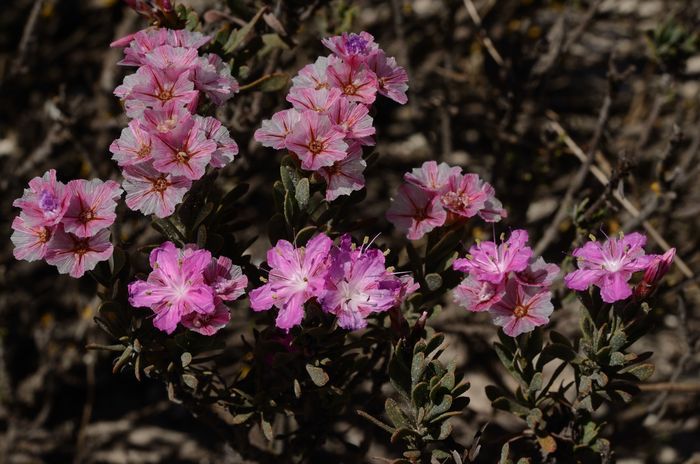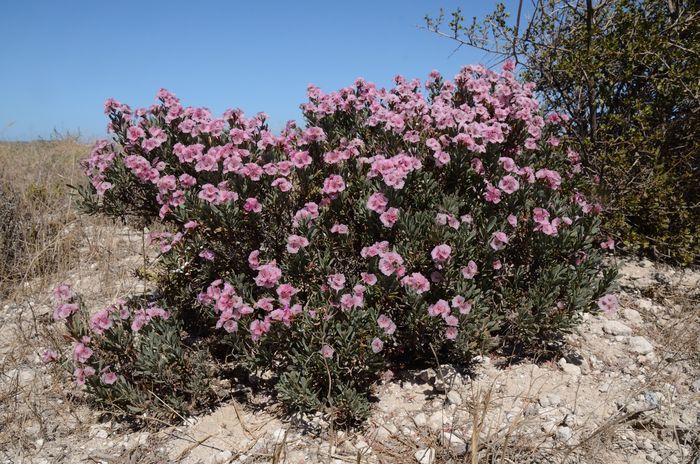Limonium capense
Limonium capense (L.Bolus) L.Bolus
Family: Plumbaginaceae
Common names: Saldanha sea-pink (Eng.); saldanha strandroos (Afr.)
Introduction
A poorly known, drought-tolerant shrublet for coastal gardens, producing masses of pink papery flowers in early summer.

Description
Description
A rounded, densely leafy, evergreen shrublet, up to 600 mm high, with rough grey bark. Leaves ascending, overlapping, twisted, oblanceolate, 18–25 × 3–4 mm, leathery, scurfy and minutely pitted.

Flowers in short spikes rarely longer than the leaves at the tips of the branches; bract 10–12 mm long, enclosing the lower half of the calyx. Calyx salver-shaped, 18–20 mm long, persistent and papery, limb reddish purple, ± 17 mm in diameter, with ten scalloped lobes Petals 5, wedge-shaped, slightly creased or wrinkled, bright pink or magenta, 15 mm long.

Conservation Status
Status
Near Threatened (NT). A locally endemic species of the West Coast that has disappeared from a significant portion of its range, through ongoing urbanization.

Distribution and habitat
Distribution description
A local endemic of coastal limestone flats on the West Coast of South Africa, from Dwarskersbos to Saldanha. The region receives moderate rainfall during the winter growing season, but is hot and dry through the summer months.
Derivation of name and historical aspects
History
The generic name is from the Latin līmōnion, used by Pliny for a wild plant and ultimately derived from the Ancient Greek leimon = meadow. A subcosmopolitan genus of ± 120 species distributed in Europe, Asia, Africa, Australia and North America. Several species are popular garden flowers under the name statice, one of which, L. sinuatum, has escaped along some parts of the West Coast.
Limonium capense, along with the other South African species with large, salver-shaped calyces, were treated in the small genus Afrolimon at one stage, but have since been confirmed as being correctly included in Limonium.

Ecology
Ecology
The pollination biology has not been studied but the pink, funnel-shaped flowers are visited by a variety of insects. One of the characteristic feature of the genus is the rough or scurfy foliage. The leaves contain numerous chalk-glands, visible as minute pits. This is a key feature that allows members of the family to survive in salty soils that would kill most other species of plants. The chalk-glands excrete excess salts dissolved in the water of the plant’s tissues, moving them out of the plant where they may crystallize or be washed away.
Uses
Use
As in other species in the genus, the colourful calyx becomes dry and papery and remains on the plant long after the petals have fallen, and the flowers are commonly known as ‘everlasting flowers’. The sprays are thus very useful in arrangements of dried flowers.
Growing Limonium capense
Grow
Nothing is known about the cultivation of Saldanha sea-pink, but it will require an open, sunny situation and probably alkaline, light, well-drained soil. It is suggested that the cultivation conditions recommended for sea-lavender, L. peregrinum are tried first. It is drought-tolerant but away from the ameliorating influence of the cold ocean, must not be allowed to dry off completely at any time of the year. Plants are best reared from seed sown in autumn in very sandy soil, and should be protected from frost.
Saldanha sea-pink is likely to be a boon for difficult windy gardens on the sandy flats around Cape Town, as well as coastal gardens in general.
References
- Dyer, R.A. 1963. Plumbaginaceae. Flora of southern Africa 26: 15–31. Department of Agricultural Technical Services, Pretoria.
- Helme, N.A., Raimondo, D., Victor, J.E. & Mucina, L. 2007. Limonium capense (L.Bolus) L.Bolus. National Assessment: Red List of South African Plants version 2017.1. Accessed on 2018/11/15
- Manning, J., Goldblatt, P. 1996. West Coast. South African Wild Flower Guide 7. Botanical Society of South Africa, Cape Town
Credits
John Manning
Compton Herbarium
December 2018
Plant Attributes:
Plant Type: Shrub
SA Distribution: Western Cape
Soil type: Sandy
Flowering season: Early Summer
PH: Acid, Alkaline, Neutral
Flower colour: Purple, Pink
Aspect: Full Sun
Gardening skill:
Special Features:
Horticultural zones








Rate this article
Article well written and informative
Rate this plant
Is this an interesting plant?
Login to add your Comment
Back to topNot registered yet? Click here to register.